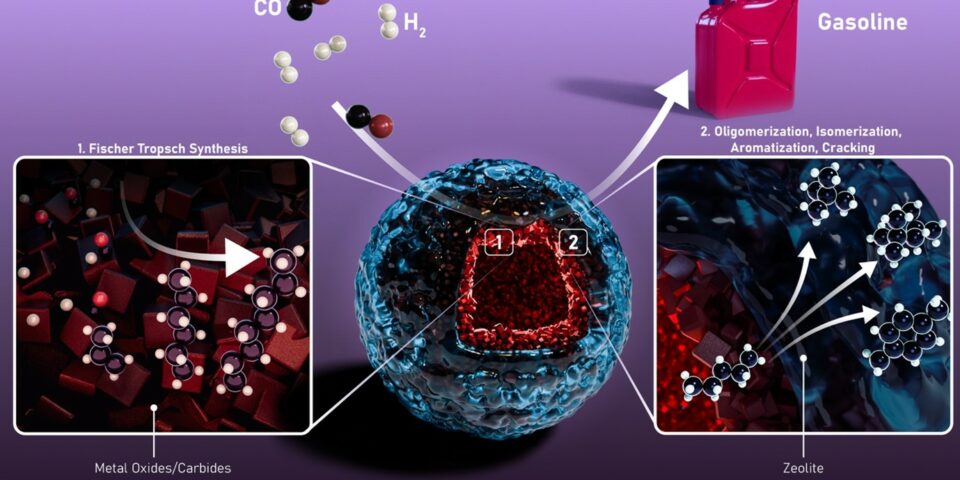An important step towards a carbon-neutral society is making transportation fuels like diesel and gasoline from carbon-neutral carbon sources like biomass, waste plastic, and even CO2. Because diesel and gasoline have quite different hydrocarbon structures, combining these two functions into one catalyst material had so far eluded researchers. A team of researchers from Utrecht University and Xiamen University in China have now shown how to make core-shell hollow-sphered materials that combine the required functions in a single catalyst particle, enabling tandem catalysis with unsurpassed performance. The results are published in Nature Materials today.
Carbon-neutral sources, like biomass, waste plastic and CO2, can be converted into synthesis gas, a mixture of CO and hydrogen, which can be further transformed to transportation fuels with the so-called Fischer-Tropsch synthesis reaction. The latter system relies on metal-based catalysts that connect carbon atoms into longer chains, requiring zeolite-based catalysts to transform the resulting molecules into the correct product specifications. Gasoline molecules are much smaller than diesel molecules, for instance, but they also are more complex. Whereas diesel consists of long straight carbon chains, gasoline requires more compact, branched molecules and carbon ring structures. The researchers from Utrecht and Xiamen have now for the first time accomplished the difficult task of combining these two functions into one single catalyst particle.
Unique combination
Research leader Prof. Bert Weckhuysen explains: “We have designed a completely new route for the synthesis of these double-shell hierarchical materials for tandem catalysis. Our unique combination of advanced synthesis skills, high-range electron microscopy, and in-situ characterization tools allowed the level of control required. With these new materials and tools, we will be better positioned to tackle the necessary transition towards a carbon-neutral society.”
Double-shell hollow spheres
Although bifunctional catalysts systems are fairly common, the challenge in the design of new materials lies in the exact details of the material interactions at molecular scale. Conventional catalysts are made by just physically mixing the ingredients, which leads to non-uniform distributions and rather poor performance. The Utrecht and Xiamen teams now have developed a new synthesis method that relies on the formation of double-shell hollow spheres that combines an excellent interaction between the components in a system where the distance that molecules have to move between the different regions is well defined, and limited. The metal shell is assembled around sacrificial carbon spheres, onto which the zeolite shell is grown by seeded crystallization.
High conversion
The various stages of the synthesis procedure can be followed very well with electron microscopic tools. High-angle annular dark-field scanning transmission electron microscopy (STEM-HAADF) was used to follow the synthesis steps. STEM-EDS (STEM coupled with energy-dispersive X-ray spectroscopy) was used to directly visualize the metal and zeolite shells. The newly prepared materials were characterized with various characterization tools, including in-situ Raman spectroscopy and in-situ X-ray diffraction. The iron oxide-zeolite ZSM-5 double-shell hierarchical systems were found to selectively produce gasoline range molecules at high conversion and outperforms existing and other reference catalyst materials.

The team
Post-Doc students Jiadong Xiao (Utrecht University) and Kan Cheng (Xiamen University) working in the teams of Professors Bert Weckhuysen (UU) and Ye Wang (XU) report on the work in Nature Materials. The Utrecht team was further completed by Professor Alfons van Blaaderen (Soft Condensed Matter, UU) and Professor Marijn van Huis from the EM-square electron microscopy center at Utrecht University.
Link to the UU press release:
Publication
Tandem Catalysis with Double-Shelled Hollow Spheres
Jiadong Xiao*, Kang Cheng, Xiaobin Xie*, Mengheng Wang, Shiyou Xing*, Yuanshuai Liu*, Thomas Hartman*, Donglong Fu*, Koen Bossers*, Marijn van Huis*, Alfons van Blaaderen*, Ye Wang and Bert Weckhuysen*
Nature Materials, 28 January 2022, DOI 10.1038/s41563-021-01183-0
* researchers affiliated with Utrecht University

